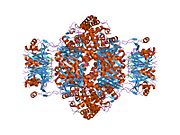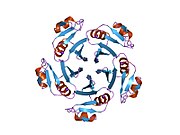GCHFR
Protein-coding gene in the species Homo sapiens
| GCHFR | |||||||||||||||||||||||||||||||||||||||||||||||||||
|---|---|---|---|---|---|---|---|---|---|---|---|---|---|---|---|---|---|---|---|---|---|---|---|---|---|---|---|---|---|---|---|---|---|---|---|---|---|---|---|---|---|---|---|---|---|---|---|---|---|---|---|
 | |||||||||||||||||||||||||||||||||||||||||||||||||||
| Identifiers | |||||||||||||||||||||||||||||||||||||||||||||||||||
| Aliases | GCHFR, GFRP, HsT16933, P35, GTP cyclohydrolase I feedback regulator | ||||||||||||||||||||||||||||||||||||||||||||||||||
| External IDs | OMIM: 602437; MGI: 2443977; HomoloGene: 3849; GeneCards: GCHFR; OMA:GCHFR - orthologs | ||||||||||||||||||||||||||||||||||||||||||||||||||
| |||||||||||||||||||||||||||||||||||||||||||||||||||
| |||||||||||||||||||||||||||||||||||||||||||||||||||
| |||||||||||||||||||||||||||||||||||||||||||||||||||
| |||||||||||||||||||||||||||||||||||||||||||||||||||
| |||||||||||||||||||||||||||||||||||||||||||||||||||
| Wikidata | |||||||||||||||||||||||||||||||||||||||||||||||||||
| |||||||||||||||||||||||||||||||||||||||||||||||||||
GTP cyclohydrolase 1 feedback regulatory protein is an enzyme that in humans is encoded by the GCHFR gene.[5][6][7]
GTP cyclohydrolase I feedback regulatory protein binds to and mediates tetrahydrobiopterin inhibition of GTP cyclohydrolase I. The regulatory protein, GCHFR, consists of a homodimer. It is postulated that GCHFR may play a role in regulating phenylalanine metabolism in the liver and in the production of biogenic amine neurotransmitters and nitric oxide.[7]
References
- ^ a b c GRCh38: Ensembl release 89: ENSG00000137880 – Ensembl, May 2017
- ^ a b c GRCm38: Ensembl release 89: ENSMUSG00000046814 – Ensembl, May 2017
- ^ "Human PubMed Reference:". National Center for Biotechnology Information, U.S. National Library of Medicine.
- ^ "Mouse PubMed Reference:". National Center for Biotechnology Information, U.S. National Library of Medicine.
- ^ Milstien S, Jaffe H, Kowlessur D, Bonner TI (Oct 1996). "Purification and cloning of the GTP cyclohydrolase I feedback regulatory protein, GFRP". J. Biol. Chem. 271 (33): 19743–51. doi:10.1074/jbc.271.33.19743. PMID 8702680.
- ^ Hochstrasser DF, Frutiger S, Paquet N, Bairoch A, Ravier F, Pasquali C, Sanchez JC, Tissot JD, Bjellqvist B, Vargas R, et al. (Mar 1993). "Human liver protein map: a reference database established by microsequencing and gel comparison". Electrophoresis. 13 (12): 992–1001. doi:10.1002/elps.11501301201. PMID 1286669. S2CID 23518983.
- ^ a b "Entrez Gene: GCHFR GTP cyclohydrolase I feedback regulator".
Further reading
- Maruyama K, Sugano S (1994). "Oligo-capping: a simple method to replace the cap structure of eukaryotic mRNAs with oligoribonucleotides". Gene. 138 (1–2): 171–4. doi:10.1016/0378-1119(94)90802-8. PMID 8125298.
- Yoneyama T, Brewer JM, Hatakeyama K (1997). "GTP cyclohydrolase I feedback regulatory protein is a pentamer of identical subunits. Purification, cDNA cloning, and bacterial expression". J. Biol. Chem. 272 (15): 9690–6. doi:10.1074/jbc.272.15.9690. PMID 9092499.
- Suzuki Y, Yoshitomo-Nakagawa K, Maruyama K, et al. (1997). "Construction and characterization of a full length-enriched and a 5'-end-enriched cDNA library". Gene. 200 (1–2): 149–56. doi:10.1016/S0378-1119(97)00411-3. PMID 9373149.
- Bader G, Schiffmann S, Herrmann A, et al. (2001). "Crystal structure of rat GTP cyclohydrolase I feedback regulatory protein, GFRP". J. Mol. Biol. 312 (5): 1051–7. doi:10.1006/jmbi.2001.5011. PMID 11580249.
- Werner ER, Bahrami S, Heller R, Werner-Felmayer G (2002). "Bacterial lipopolysaccharide down-regulates expression of GTP cyclohydrolase I feedback regulatory protein". J. Biol. Chem. 277 (12): 10129–33. doi:10.1074/jbc.M107326200. PMID 11799107.
- Strausberg RL, Feingold EA, Grouse LH, et al. (2003). "Generation and initial analysis of more than 15,000 full-length human and mouse cDNA sequences". Proc. Natl. Acad. Sci. U.S.A. 99 (26): 16899–903. Bibcode:2002PNAS...9916899M. doi:10.1073/pnas.242603899. PMC 139241. PMID 12477932.
- Gesierich A, Niroomand F, Tiefenbacher CP (2003). "Role of human GTP cyclohydrolase I and its regulatory protein in tetrahydrobiopterin metabolism". Basic Res. Cardiol. 98 (2): 69–75. doi:10.1007/s00395-003-0394-y. PMID 12607127. S2CID 19864675.
- Gerhard DS, Wagner L, Feingold EA, et al. (2004). "The Status, Quality, and Expansion of the NIH Full-Length cDNA Project: The Mammalian Gene Collection (MGC)". Genome Res. 14 (10B): 2121–7. doi:10.1101/gr.2596504. PMC 528928. PMID 15489334.
- Kalivendi S, Hatakeyama K, Whitsett J, et al. (2006). "Changes in tetrahydrobiopterin levels in endothelial cells and adult cardiomyocytes induced by LPS and hydrogen peroxide--a role for GFRP?". Free Radic. Biol. Med. 38 (4): 481–91. doi:10.1016/j.freeradbiomed.2004.11.004. PMID 15649650.
- Chavan B, Gillbro JM, Rokos H, Schallreuter KU (2007). "GTP cyclohydrolase feedback regulatory protein controls cofactor 6-tetrahydrobiopterin synthesis in the cytosol and in the nucleus of epidermal keratinocytes and melanocytes". J. Invest. Dermatol. 126 (11): 2481–9. doi:10.1038/sj.jid.5700425. PMID 16778797.
- Ohta E, Funayama M, Ichinose H, et al. (2006). "Novel mutations in the guanosine triphosphate cyclohydrolase 1 gene associated with DYT5 dystonia". Arch. Neurol. 63 (11): 1605–10. doi:10.1001/archneur.63.11.1605. PMID 17101830.
- Kontostavlaki DP, Panayotacopoulou MT, Sluijs JA, et al. (2007). "Co-expression of tyrosine hydroxylase and GTP cyclohydrolase I in arginine vasopressin-synthesizing neurons of the human supraoptic nucleus demonstrated by laser microdissection and real-time PCR". Neuroendocrinology. 84 (6): 386–95. doi:10.1159/000097487. PMID 17135716. S2CID 40550512.
- Nandi M, Kelly P, Vallance P, Leiper J (2008). "Over-expression of GTP-cyclohydrolase 1 feedback regulatory protein attenuates LPS and cytokine-stimulated nitric oxide production". Vasc. Med. 13 (1): 29–36. doi:10.1177/1358863X07085916. PMID 18372436. S2CID 8626710.
- Ionova IA, Vasques-Vivar J, Whitsett J, et al. (2008). "Deficient BH4 production via de novo and salvage pathways regulates NO responses to cytokines in adult cardiac myocytes". Am. J. Physiol. 295 (5): H2178–87. doi:10.1152/ajpheart.00748.2008. PMC 2614582. PMID 18835915.
- v
- t
- e
PDB gallery
-
 1is7: Crystal structure of rat GTPCHI/GFRP stimulatory complex
1is7: Crystal structure of rat GTPCHI/GFRP stimulatory complex -
 1is8: Crystal structure of rat GTPCHI/GFRP stimulatory complex plus Zn
1is8: Crystal structure of rat GTPCHI/GFRP stimulatory complex plus Zn -
 1jg5: CRYSTAL STRUCTURE OF RAT GTP CYCLOHYDROLASE I FEEDBACK REGULATORY PROTEIN, GFRP
1jg5: CRYSTAL STRUCTURE OF RAT GTP CYCLOHYDROLASE I FEEDBACK REGULATORY PROTEIN, GFRP -
 1wpl: Crystal structure of the inhibitory form of rat GTP cyclohydrolase I/GFRP complex
1wpl: Crystal structure of the inhibitory form of rat GTP cyclohydrolase I/GFRP complex
 | This article on a gene on human chromosome 15 is a stub. You can help Wikipedia by expanding it. |
- v
- t
- e





















